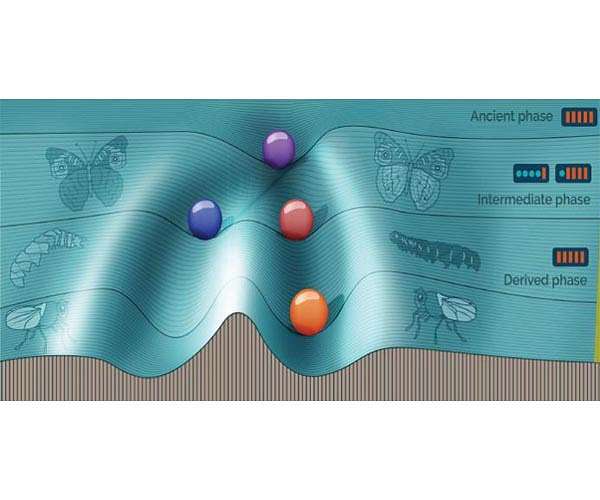
Simulating evolution to understand a hidden switch
Computer simulations of cells evolving over tens of thousands of generations reveal why some organisms retain a disused switch mechanism that turns on under severe stress, changing some of their characteristics. Maintaining this "hidden" switch is one means for organisms to maintain a high degree of gene expression stability under normal conditions.Tomato hornworm larvae are green in warmer regions, making camouflage easier, but black in cooler temperatures so that they can absorb more sunlight. This phenomenon, found in some organisms, is called phenotypic switching. Normally hidden, this switching is activated in response to dangerous genetic or environmental changes.Scientists have typically studied this process by investigating the changes undergone by organisms under different circumstances over many generations. Several years ago, for example, a team bred generations of tobacco hornworm larvae to observe and induce color changes similar to those that occurred in their tomato hornworm relatives."Computer simulations, when built on reasonable assumptions and conducted under careful control, are a very powerful tool to mimic the real situation," says KAUST computational bioscientist Xin Gao. "This helps scientists observe and understand principles that are otherwise very difficult, or impossible, to observe by wet-lab experiments."Gao and KAUST research scientist Hiroyuki Kuwahara designed a computer simulation of the evolution of 1,000 asexual microorganisms. Each organism was given a gene circuit model for regulating the expression of a specific protein X.The simulation evolved the population over 90,000 generations. The original founding population had identical nonswitching gene circuits and evolved over 30,000 generations, collectively called the ancient population, under stable conditions. The next 30,000 generations, called the intermediate population, were exposed to fluctuating environments that switched every 20 generations. The final 30,000 generations, the derived population, were exposed to a stable environment.The individuals in the ancient and derived populations, who evolved in stable environments, both had gene expression levels that were optimized for stability. But they were different: the ancient population's stability did not involve phenotypic switching, while the derived population's did. The difference, explains Kuwahara, stems from the intermediate population, in which switching was favored in order to deal with the fluctuating conditions.The simulations suggest that populations of organisms maintain their switching machinery over a long period of environmental stability by gradually evolving low-threshold switches, which easily switch in fluctuating circumstances, to high-threshold switches when the environment is more stable.This is easier, says Kuwahara, than reverting to a nonswitching state through small mutational shifts. "Instead, we end up with a type of 'hidden' phenotypic switching that acts like an evolutionary capacitor, storing genetic variations and releasing alternative phenotypes in the event of substantial perturbations," Kuwahara says.The team next plans to use computer simulations to study more complex biological systems while also interactively collaborating with researchers conducting wet-lab experiments. Their aim is to develop theoretical frameworks that can be experimentally validated.Research paperRelated LinksKing Abdullah University Of Science and TechnologyLands Beyond Beyond - extra solar planets - news and scienceLife Beyond EarthThanks for being there;We need your help. The SpaceDaily news network continues to grow but revenues have never been harder to maintain.With the rise of Ad Blockers, and Facebook - our traditional revenue sources via quality network advertising continues to decline. And unlike so many other news sites, we don't have a paywall - with those annoying usernames and passwords.Our news coverage takes time and effort to publish 365 days a year.If you find our news sites informative and useful then please consider becoming a regular supporter or for now make a one off contribution.SpaceDaily Monthly Supporter$5+ Billed MonthlySpaceDaily Contributor$5 Billed Oncecredit card or paypalDiscovery boosts theory that life on Earth arose from RNA-DNA mixLa Jolla CA (SPX) Dec 31, 2020Chemists at Scripps Research have made a discovery that supports a surprising new view of how life originated on our planet. In a study published in the chemistry journal Angewandte Chemie, they demonstrated that a simple compound called diamidophosphate (DAP), which was plausibly present on Earth before life arose, could have chemically knitted together tiny DNA building blocks called deoxynucleosides into strands of primordial DNA. The finding is the latest in a series of discoveries, over ... read more
……Read full article on Space Daily
Science News
Comments
Leave a comment in Nestia App